Art in NYC: Gerhard Richter Painting After All at the MetMuseum
While MetMuseum has temporarily closed, you can visit it online from anywhere
Presenting a major exhibition of works by German artist Gerhard Richter titled “Painting After All”, the exhibit spans the entire artist’s career
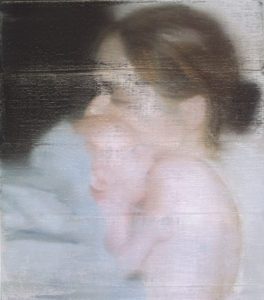
Recognized as one of the greatest artists of our time, Gerhard Richter succeeds in combining the detailed pictorial approach with the haze caused by the fog of time. His celebrated blurred figurative paintings, large scale abstract compositions, and monumental glass sculptures are the treasures of the art museums all around the world. Originally scheduled to be on view at the Met Breuer from March 4 – July 5, 2020, the exhibition includes a range of artworks from the artist’s early experiments with the pictorial depictions based on the old photographs, the glass sculptures, and the most recent cycle House of Cards (5 Panes) (2020). Some of the works will be more familiar to the art lovers, while others like the cycles Cage (2009) and Birkenau (2014) are shown in the United States for the first time.
Well known for his effort to reconcile through art the historical past with personal memories, Richter is uniquely qualified to remind the viewers about the horror of war, the danger of manipulation through the isolated messages or images taken out of context, and the inconsistencies in the recollection of the past events. To accentuate the point of a fleeting chance of memory, his technique of smudging the clear image reminds us of the distortion brought on by the time.
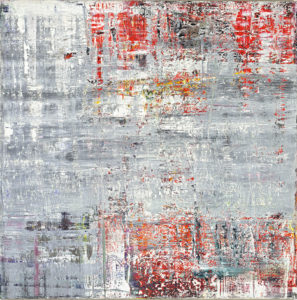
The technique can be seen as a way to represent the perspective of time similar to the perspective of distance and space. It creates the fourth dimension (time) for otherwise ordinary snapshots. As the objects positioned far away are depicted proportionally smaller and with less visible details, the memories about the events from the past are covered in haze and come out with blurred outlines. One can still see the object, yet as years go by, the exact image loses its significance and is replaced by the vague outline.
Explore the show online by taking a virtual tour.
The exhibition at the Met Breuer is the first major expose of Richter’s art in the US in 20 years.
Stay in the know about future events and offers by subscribing to ARTS-NY newsletter Subscribe
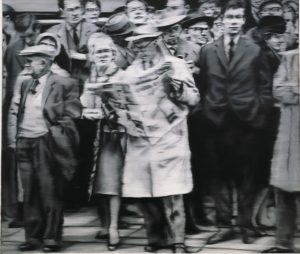
Born in 1932 in Dresden, Germany, Richter was too young to be recruited for Hitler Jugen but mature enough to observe and remember the war. As Dresden became part of East Germany after WWII, his education as a mural painter at the Dresden Fine Art Academy was in the strict dictum of the Socialist Realism traditions.
With his first wife, he escaped to the West in 1961 right before the Berlin Wall was built. There in Dusseldorf, West Germany, he joint the Capitalist Realism movement in direct opposition to Socialist Realism, an official art doctrine of the East. However, as many escapees and newcomers to the consumerist reality of the Capitalist society, Richter took a critical look at its canons and visible amnesia of recent history. Through his art, he channeled the complicated connection and collective reckoning with Nazism for German nationals in general, and each individual in particular. He was keenly aware and circumspect about the familial ties to those who were unwillingly or otherwise recruited for the war efforts or were persecuted by the Nazis.
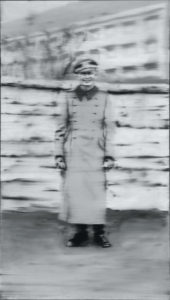
Throughout his prodigious career, Richter experimented with figurative as well as abstract paintings, large scale glass and mirror installations, algorithmic color charts, portraits, and landscapes. Artworks in various mediums are part of the current exhibit.
“Painting After All” occupies two floors of the cavernous Met Breuer museum and starts with 11 Panes (2004) made of the tempered glass. It’s the first work that greets the viewers. The installation of the towering layers of glass panels makes distorted reflection which sets the tone for the rest of the exposition.
Following the chronological timeline, the first painting in the exhibition is Table (1962) which was also the first painting that Richter made after arrival to the West. Pointing to the banal, mass-produced object photographed for an Italian design magazine, it is painted in the characteristic “erasure”-style embraced by the artist. The next galleries present oil paintings which are also based on the photo images and newspaper cutouts with the signature blurring of lines and figures. Based on the family photos sent by Richter’s mom from Dresden in a shoebox, the artworks are full of the complexities and grief for the impossible choices posed to ordinary people. The most celebrated works, Tante Marianne and Uncle Rudi, coming literally from the same photo album, bring with them a personal history that is a grave reminder of the war horrors for people caught in crosshairs.
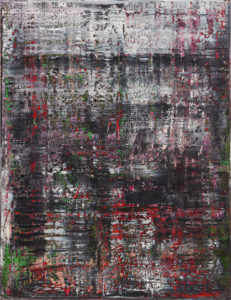
The exhibition features two cycles that are exhibited in the US for the first time. Six oil on canvas paintings in the “Cage” cycle (2006) is influenced by the music of the American composer John Cage. The cycle perpetuates a notion that even an infinite cancellation and destruction are unable to make a complete erasure of either the colors applied before or the events and deeds that happened prior. The cycle “Birkenau” (2014) of four large oil on canvas works and four inkjet prints of the same paintings make a powerful reminder that the unthinkable horrors can be repeated. The cycle was created after the photographs made at Birkenau Nazi extermination camp by a member of Sondercommando.
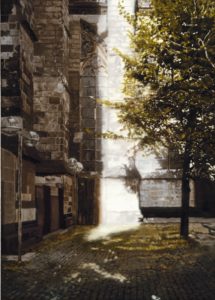
Richter’s genius employs the art to stress the schism between forgetting and remembering when its impossible to forget yet it is equally difficult to remember. Our memory is a sequence of snapshots from the past and what we see around us now. As time goes by, the memory gets crowded and overlaid with the new snapshots over and over again. The older ones fade and become blurred out and hard to see like something at a distance. Richter’s style of overlaying and erasing replicates the memory process. It is disturbing and unclear at first but repeated over and over again it makes a point that life is too complex to be represented by an image. An artist can only show the outlines; the rest is up to the viewers.
Stay in the know about future events and offers by subscribing to ARTS-NY newsletter Subscribe
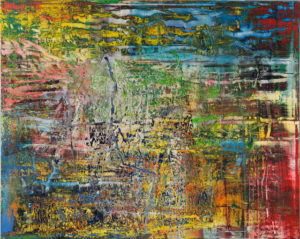
From 1966 Richter was making artworks that dealt with mathematical phenomena of randomness as something that cannot be seen by the naked eye. His experimentation with chance started in his work with Blinky Palermo who called out a random color to be used next in Richter’s abstract painting. Later in 2007, Richter used a random color generator algorithm to assemble the panels for 4,900 Colors compositions on view in the exhibit. While using the same set of 196 colors, each pane in the composition is unique because of the algorithmic sequence of the color plates used for that particular installation. This accentuates the value of chance as something that is hard to control.
Allow enough time to immerse yourself into the art that challenges the perception of history, the memory of the past, and the world around us. Visit MetMuseum website for the video-interviews with the artists about his art, its meaning, his creative process, and much more. The exhibit is accompanied by the exhaustive catalogue Richard Richter: Painting After All that spans the artist’s career.
Explore the show online by taking a virtual tour.
 Dates: March 4 – July 5, 2020
Dates: March 4 – July 5, 2020
Venue: The Met Breuer, 945 Madison Ave., NY, NY
 Dates: March 4 – July 5, 2020
Dates: March 4 – July 5, 2020
One thought to “Art in NYC: Gerhard Richter Painting After All at the MetMuseum”
Comments are closed.